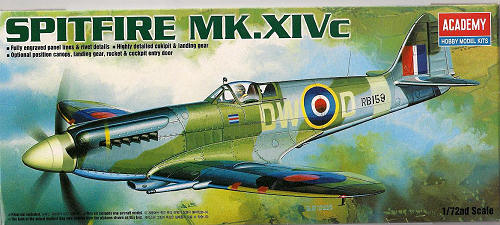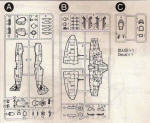
| KIT #: | 2130 |
| PRICE: | NZ $16.99 |
| DECALS: | One option |
| REVIEWER: | Zac Yates |
| NOTES: |

| HISTORY |
With twice the horsepower of Spitfire prototype K5054 (2035hp as opposed to
around 990) the XIV was the ultimate version of the superlative British fighter
to see widespread service during World War Two. The XIV married a powerful
Rolls-Royce Griffon to a strengthened airframe, including larger tail surfaces,
which with a five-bladed propeller helped to absorb the power of the monster
engine. The initial production aircraft featured the standard canopy and
“high-back” fuselage, but later for better pilot visibility a “low-back”/bubble
canopy combination was introduced, and along with clipped wings for tighter
turns at low level the XIV reached its final form.
The new engine rotated in the opposite direction to the original Merlin, and as
a result several were written off in take-off accidents. But despite such
teething problems the XIV proved itself in combat and in use against the V-1
“doodlebug” bomb on so-called “Anti-Diver” missions. Later FR.XIV variants
featured cameras so that the aircraft could perform the dual roles of fighter
and reconnaissance platform.
Around half a dozen remain airworthy around the world, with more under restoration.
| THE KIT |
 Three
words: typical Academy fare. That is, very fine engraved detail everywhere on
nice medium grey plastic (two sprues) and one sprue of clear (including
rear-view mirror and gunsight).
Three
words: typical Academy fare. That is, very fine engraved detail everywhere on
nice medium grey plastic (two sprues) and one sprue of clear (including
rear-view mirror and gunsight).
Thoughtfully Academy have included two
canopies: one closed and a three-piece one to be posed open. Not sure how this
latter set fits, but good on them for doing it. Additionally, the cockpit entry
door is separate to allow you to pose it open if you so desire (although this
looks a little short and stubby when compared to photos of a 1:1 Spitfire XIV).
Another interesting option is the separate radiator doors, allowing you to pose
them open or closed, not something I’ve seen on any other Spitfire kit. The
large cowling bulges which make the Griffon marks so distinctive are separate on
this kit, but judging by the box photos it looks about right. The locating areas
for the bulges are moulded with a rough surface so that they are correctly
placed.
To my eye the cockpit detail is superb for a 1:72 kit. The control stick is a
very nice representation of the spade grip found in Spits, the detail on the
frames is also quite nice, and the instrument panel has very fine raised detail.
Some drybrushing will really make this look a million dollars. Armour plating
for the seat is included, as are separate (and very small) rudder pedals. Based
on my photos of a locally-based Mk.IXc the sidewall detail looks about right,
but there are enough reference photos of the Spit online that those so inclined
can superdetail. There is very little flash on the sprues.
Being a XIVc the kit features a “C” wing, i.e. two 20mm Hispano cannon and four
.303 Browning machineguns. The cannon and stubs are mounted integrally with the
upper wing parts, and the MG muzzle holes are already open. The underwing
ejector chutes for spent shells are recessed, which suits me fine, but some may
choose to open these. The wheel wells are closed in, but are not very deep and
feature little detail. According to the instructions the undercarriage doors
need trimming for the “Stationary Version”, or can be left as is for the “Flying
Version”....of which no further mention is made....This aside, the tyres are
moulded with flat bottoms (four spoke wheel rims), and the oleo “scissors” are
separate from the main leg. The retractable tailwheel has separate doors, but no
detail at all in its bay. The large undernose intake is moulded into the lower
wing, but with a separate nose piece. The tubular exhaust stacks look very
simple, but should to the job. And, music to the ears of any Spit aficionado,
the “gull” is present under the rear fuselage/wing root join.
The only real “glitch” I can see are the prop blades, which have a very wide
chord at the root unlike any props on pictures of Griffon Spits I’ve seen. I’m
not sure if any aftermarket options are out there, but I would suggest seeking
them or sanding down the kit blades. They are supplied individually to be
cemented to the backplate, the spinner going on top of this.
Eight unguided rockets, mounted vertically in pairs with separate fins, are
included for installation. Locating holes for these must be drilled. In the few
reviews of this kit I’ve read on the Internet, everyone says that the subject
aircraft (RB159) never carried rockets and thus the kit is somewhat spurious. I
have no info on Griffon Spits and, as I don’t intend to build the kit with the
included decals, I don’t mind if it is wrong. The decals are quite shiny, and
include no stencils except for wing walkway stripes and some wording for the
door. Very kindly a representation
of the pilot’s harness is included on the decal sheet. Red rectangles are
supplied for the doped-over gun covers on the wing leading edge. As the holes
for the guns are pre-drilled the result will look very realistic.
| CONCLUSIONS |
This kit is, in
| REFERENCES |
Wikipedia
Googling “Spitfire XIVc”
Warbirds Over Wanaka ’94,
Airliners.net
Various modelling websites
Zac Yates
June 2009
If you would like your product reviewed fairly and quickly, please contact me or see other details in the Note to Contributors.
Back to the Previews Index Page